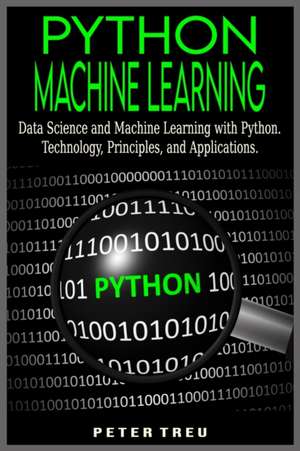Python Machine Learning for Beginners
Autor Peter Treuen Limba Engleză Paperback – 4 noi 2020
Machine learning stems from this question: Can a computer go beyond anything we can order to do and learn by itself to do a specific task? Can a laptop surprise us? Instead of having programmers carefully and manually writing a set of data processing rules, can a computer automatically learn these rules by merely looking at the data?
This question paves the way for a new programming paradigm. In classical programming, on which symbolic artificial intelligence is based, human beings insert rules (the program) and the data to be processed according to these rules and obtain answers. Humans enter data and expected responses based on that data with machine learning, and the computer identifies the practices. These rules can then be applied to other data to produce different, original answers.
A machine learning system is trained and not programmed. He is presented with numerous examples relevant to a given task. In these examples, he finds a statistical structure that ultimately allows him to produce the rules for the task's automation. For example, to automate tagging vacation photographs, many examples of images already tagged by humans could be presented to a machine learning system. The system would be tasked with learning the statistical rules based on associating individual images with specific tags.
Machine learning is closely related to statistics, but it differs from them in many important ways. Unlike statistics, machine learning tends to operate with large and complex datasets (such as a dataset of millions of images, each consisting of tens of thousands of pixels) for which classical statistical analysis such as Bayesian analysis would not be usable. . As a result, machine learning, and especially deep learning, exhibits somewhat limited mathematical theory - sometimes too much - and is more technical than mathematical. It is a practical discipline in which ideas often prove more empirically than theoretical.
In this Book you will learning:
- What is Data Science and Deep Learning?
- Data Science and Applications
- Probability - Fundamental - Statistics
- Understanding the Fundamentals of iMachine Learning
- Types of MachineiLearning
- What is iPython? SettingiUp the Environment in Python
- K - Nearest Neighbor Algorithms
- Means Clustering
- Neural Networks - Linear Classifiers
While most books focus on advanced predictive models, this book begins to explain the basic concepts and how to correctly implement Data Science and Machine Learning, with practical examples and simple coding scripts.
This guide provides the necessary knowledge in a practical way. You will learn the steps of Machine Learning, how to implement them in Python, and the most important applications in the real world.
Would you like to know more?
Download the Book, Python Machine Learning.
Scroll to the top of the page and click the "Buy now"button to get your copy now.
| Toate formatele și edițiile | Preț | Express |
|---|---|---|
| Paperback (1) | 109.35 lei 38-44 zile | |
| Charlie Creative Lab – 4 noi 2020 | 109.35 lei 38-44 zile | |
| Hardback (1) | 152.29 lei 38-44 zile | |
| Charlie Creative Lab – 5 dec 2020 | 152.29 lei 38-44 zile |
Preț: 109.35 lei
Preț vechi: 136.69 lei
-20% Nou
Puncte Express: 164
Preț estimativ în valută:
20.92€ • 21.95$ • 17.42£
20.92€ • 21.95$ • 17.42£
Carte tipărită la comandă
Livrare economică 28 martie-03 aprilie
Preluare comenzi: 021 569.72.76
Specificații
ISBN-13: 9781801204392
ISBN-10: 180120439X
Pagini: 138
Dimensiuni: 152 x 229 x 7 mm
Greutate: 0.2 kg
Editura: Charlie Creative Lab
ISBN-10: 180120439X
Pagini: 138
Dimensiuni: 152 x 229 x 7 mm
Greutate: 0.2 kg
Editura: Charlie Creative Lab
